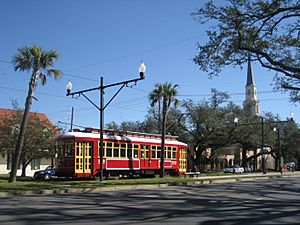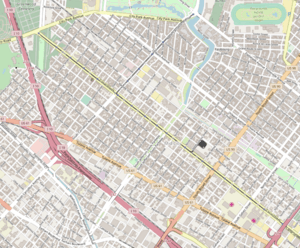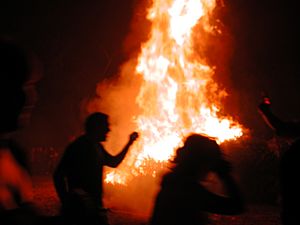Mid-City New Orleans facts for kids
Quick facts for kids
Mid-City
|
|
|---|---|
|
New Orleans neighborhood
|
|

Canal Streetcar in Mid-City
|
|
 |
|
| Country | United States |
| State | Louisiana |
| City | New Orleans |
| Planning District | District 4, Mid-City District |
| Area | |
| • Total | 1.66 sq mi (4.3 km2) |
| • Land | 1.66 sq mi (4.3 km2) |
| • Water | 0.00 sq mi (0 km2) |
| Elevation | 0 ft (0 m) |
| Population
(2010)
|
|
| • Total | 6,217 |
| • Density | 3,745/sq mi (1,446/km2) |
| Time zone | UTC-6 (CST) |
| • Summer (DST) | UTC-5 (CDT) |
| Area code(s) | 504 |
|
Mid-City Historic District
|
|
| Lua error in Module:Location_map at line 420: attempt to index field 'wikibase' (a nil value). | |
| Location | Roughly bounded by Derbigny St., Conti St., City Park Ave. and I-10, New Orleans, Louisiana |
|---|---|
| Area | 850 acres (340 ha) |
| Architect | Multiple |
| Architectural style | Bungalow/Craftsman, Colonial Revival, Italianate |
| NRHP reference No. | 93001394 |
| Added to NRHP | December 10, 1993 |
Mid-City is a cool neighborhood in the city of New Orleans. It's known for being a historic area. This means it has many old buildings and places that are important to history. The City Planning Commission says Mid-City is bordered by streets like City Park Avenue, Toulouse Street, North Carrollton, and Orleans Avenue. It also touches Bayou St. John and the Pontchartrain Expressway. But many people think of Mid-City as an even bigger area around these borders.
Contents
Exploring Mid-City's Location
Mid-City is located right in the middle of New Orleans. It sits on land that was once a low-lying area. This area was part of the Mississippi River's natural flood plain. Because of this, it wasn't settled as early as other neighborhoods. People used to call it the "back of town."
The city used to end at the swamp. Now, it reaches all the way to the lake. Mid-City was once part of a "backswamp" area. This changed when people started developing the land in the late 1800s and early 1900s.
Neighboring Areas Around Mid-City
Mid-City is surrounded by several other interesting neighborhoods:
- Navarre (north)
- City Park (north)
- Bayou St. John (north)
- Tulane/Gravier (east)
- Gert Town (south)
- Dixon (west)
- Lakewood (west)
Official Mid-City Borders
The City Planning Commission has set clear boundaries for Mid-City. These boundaries are defined by specific streets. They include City Park Avenue, Toulouse Street, North Carrollton Avenue, and Orleans Avenue. The neighborhood also borders Bayou St. John, St. Louis Street, North Broad Street, and the Pontchartrain Expressway.
People and Community in Mid-City
Mid-City is a very diverse neighborhood. It has people from many different backgrounds. This mix comes from its location, being close to both uptown and downtown areas. In 2010, about 14,633 people lived in Mid-City.
Cool Places and Landmarks
Mid-City is home to many important city landmarks. Canal Street is one of the most important streets in New Orleans. It cuts right through the middle of Mid-City. The famous streetcar route follows Canal Street. It goes all the way to Carrollton Avenue, another well-known street in the area.
Tulane Avenue also runs through Mid-City. Before big highways, this was the main road into New Orleans from Baton Rouge. You'll also find Jefferson Davis Parkway here. This parkway is named after a historical figure.
Important Buildings in Mid-City
You can see many prominent buildings in Mid-City. These include the Orleans Parish Criminal Court and Jesuit High School. Warren Easton High School is also located here. There are also many churches and large houses along Canal Street.
Many buildings show the area's past. For example, Tulane Avenue has reminders of its industrial history. However, Mid-City is mostly a residential neighborhood. You'll see many shotgun houses and larger homes.
Mid-City's Local Culture
Mid-City is a neighborhood that mostly serves its local residents. It has a unique local feel. Restaurants and bars here mostly cater to people who live in the area. This makes it a great place to experience the true local flavor of New Orleans.
Before Hurricane Katrina, there was a special New Year's Eve tradition. Residents would gather their Christmas trees. They would then place them in an area on Orleans Avenue. They would create a huge bonfire with the trees. People would even throw fireworks into the bonfire! It was a fun and exciting way to celebrate the new year.
Mid-City After Hurricane Katrina
Mid-City faced a lot of flooding after Hurricane Katrina. The community has been working hard to rebuild ever since. Many people have moved back and are helping to reconstruct the area. By March 2007, about 55% of the residents had returned home.
Learning and Schools in Mid-City
Mid-City has several schools for students. The New Orleans Public Schools and Recovery School District manage the public school system.
Warren Easton Senior High School is a well-known school located right in Mid-City. The neighborhood also has the Mid-City Branch of the New Orleans Public Library. This library is a great place for kids to read and learn.


